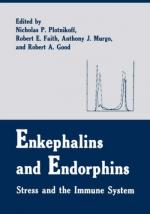|
This section contains 506 words (approx. 2 pages at 300 words per page) |

|
When a person is injured, pain impulses travel up the spinal cord to the brain, which then releases endorphins and enkephalins, the body 's natural painkillers. Enkephalins block pain signals in the spinal cord, while endorphins are thought to alleviate pain principally at the brainstem. Both are morphine-like substances whose functions are similar to those of opiate drugs.
Today, the word endorphin—a combination of "endo" from endogenously manufactured (i.e. manufactured within the human body) and "orphin" from morphine-like substances--is used generically to describe both groups of painkillers. These endogenous opiates include enkaphalins (methionine and leucine), endorphins (alpha, beta, gamma, and sigma) and a growing number of synthetic compounds.
The discovery of these neurochemicals occurred after several bodies of research were conducted and compared. In 1965, at the University of California, San Francisco, Chinese-born biochemist Choh Hao Li and David Chung reported the...
|
This section contains 506 words (approx. 2 pages at 300 words per page) |

|


